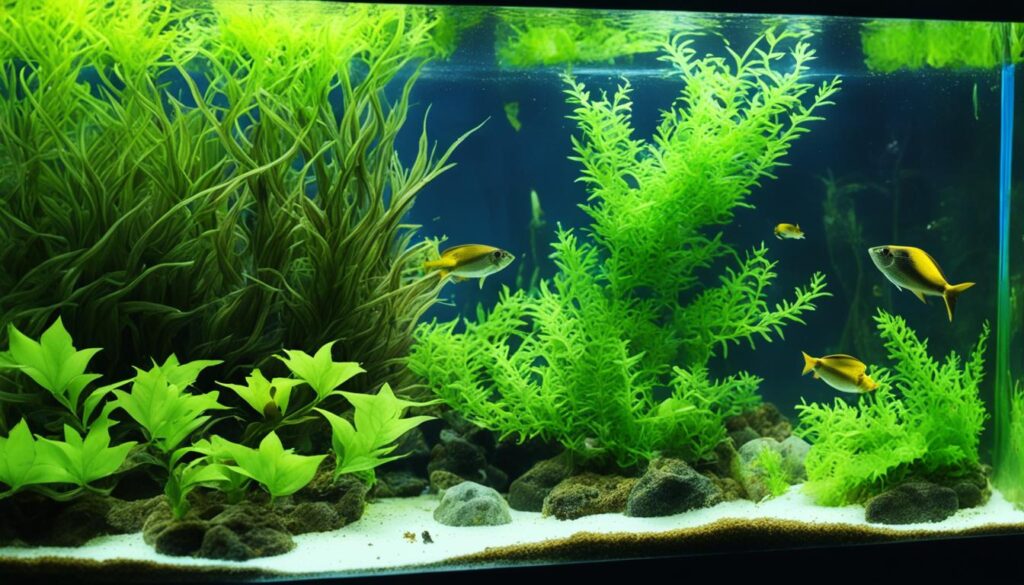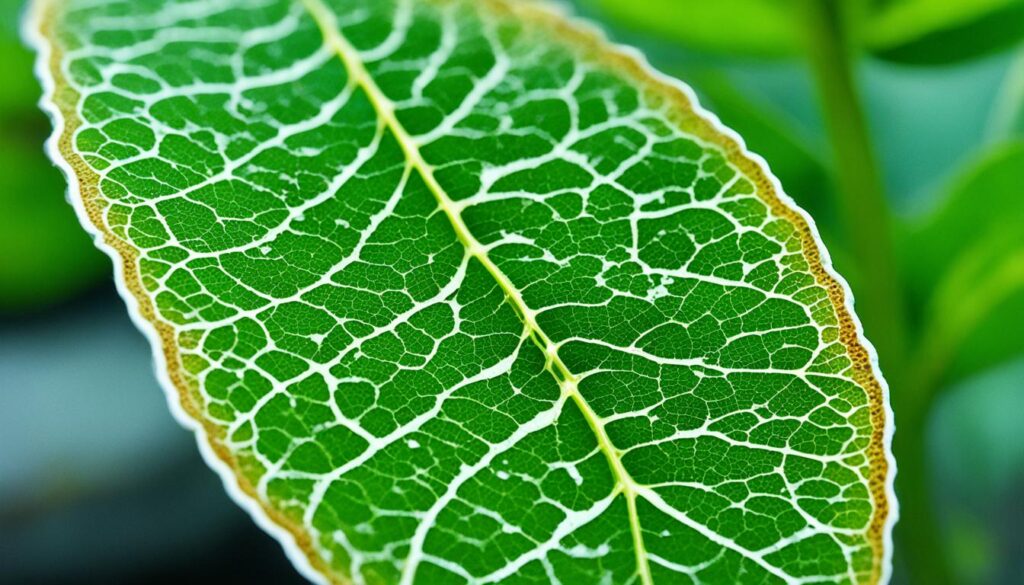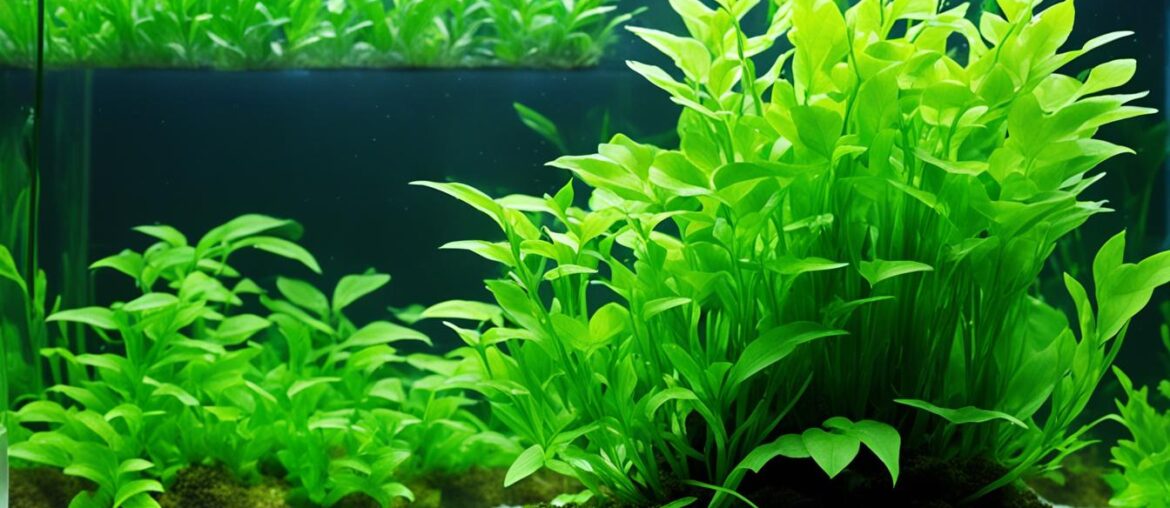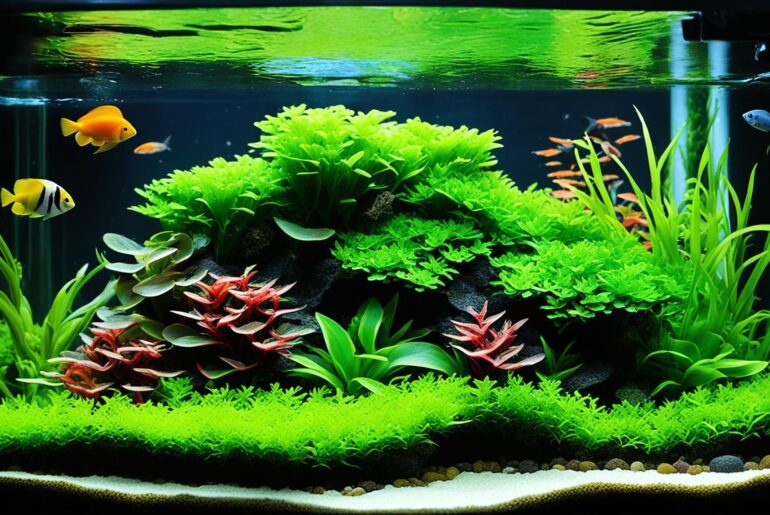As an avid aquarium enthusiast, there’s nothing quite like the satisfaction of watching your aquatic plants flourish and create a vibrant underwater landscape. However, I still vividly remember a time when my plants struggled to grow, withering away before my eyes. It was a disheartening experience that made me question my ability to care for these delicate organisms.
But instead of giving up, I embarked on a journey to understand the root cause of the problem. That’s when I discovered the crucial role of plant nutrients and how nutrient deficiencies can sabotage even the most dedicated aquarium keeper’s efforts.
Through careful observation and research, I learned to recognize the subtle signs of nutrient deficiency in my aquatic plants. It was like unlocking a secret language – yellowing leaves, pinholes, and discoloration all became meaningful clues that could guide me in providing the right nutrients to rejuvenate my underwater garden.
By addressing these deficiencies and tailoring my fertilization routine to meet my plants’ specific needs, I witnessed a remarkable transformation. The plants that once struggled began to thrive, their leaves vibrant and healthy, and their growth propelled by the essential building blocks they had been missing.
If you, too, yearn to create a flourishing underwater oasis, join me in exploring the world of aquarium plant nutrient deficiencies. In this article, I will share my knowledge and experience to help you identify and address these deficiencies, ensuring the health and vitality of your beloved aquatic plants.
Key Takeaways:
- Understanding nutrient deficiency symptoms is crucial for maintaining healthy aquarium plants.
- Recognize signs such as yellowing leaves, pinholes, and leaf discoloration to identify specific deficiencies.
- Tailor your fertilization routine to address nutrient imbalances and provide the necessary building blocks for plant growth.
- Regular observation and care are key to creating a vibrant underwater landscape.
- By addressing nutrient deficiencies, you can unlock the true potential of your aquarium plants and experience the joy of a thriving aquatic ecosystem.
Types of Plant Nutrient Deficiencies
In order to maintain optimal plant health and growth, it is important to understand the various types of nutrient deficiencies that can affect aquatic plants. These deficiencies can hinder the plants’ ability to perform essential functions and can manifest in different ways, often visible through changes in the condition of their leaves.
To help you identify and address these nutrient imbalances, here are the main types of plant nutrient deficiencies commonly observed in aquatic plants:
| Nutrient Deficiency | Symptoms |
|---|---|
| Nitrogen Deficiency | Yellowing and translucency of old leaves, starting from the leaf tips. New plants may exhibit yellow or translucent leaves. |
| Iron Deficiency | Yellowing or paleness on the newest leaves, while the older leaves remain normal. |
| Potassium Deficiency | Development of small pinholes on leaves, often rimmed with brown or yellow. |
| Phosphate Deficiency | Yellowing of older leaves, along with the appearance of soggy brown patches. |
| Magnesium Deficiency | Lighter color leaves with dark veins, primarily affecting older leaves. Drooping leaf edges may also be observed. |
| Calcium Deficiency | Twisted and gnarled growth of new leaves. |
By understanding the specific symptoms associated with each deficiency, you can accurately diagnose and address the nutrient imbalance in your aquarium. Let’s dive into each deficiency in more detail, exploring their distinct signs and the best ways to rectify them.
Nitrogen Deficiency Symptoms
As an aquarium enthusiast, I understand the importance of maintaining optimal conditions for the health and vibrancy of our aquatic plants. One common issue that many hobbyists encounter is nitrogen deficiency. This occurs when the levels of nitrogen, an essential plant nutrient, become depleted in the tank. In this section, we will explore the signs and symptoms of nitrogen deficiency in aquarium plants.
The first indicator of nitrogen deficiency is the yellowing of old leaves, beginning from the tips. This happens because plants prioritize nutrient allocation to newer leaves at the top by extracting nutrients from the bottom leaves. As a result, the lower leaves start to turn yellow and may even become translucent.
It’s crucial to note that yellow or translucent leaves on new plants may not necessarily indicate nitrogen deficiency but rather melting, which is a different issue. Melting refers to the process in which new plants shed their old leaves while transitioning to a submerged environment. To accurately determine the cause of yellow or translucent leaves, it’s essential to differentiate between nitrogen deficiency and melting.
To address nitrogen deficiency in your aquarium plants, you need to adjust your fertilization routine. Adding nitrogen-rich fertilizers or supplements will provide the necessary nutrients for healthy plant growth. Regularly monitoring nitrogen levels and ensuring a balanced nutrient supply is crucial for maintaining the health and vitality of your aquatic plants.
| Symptoms | Description |
|---|---|
| Yellowing of old leaves | The lower leaves turn yellow, starting from the tips, due to nitrogen deficiency. |
| Translucency of old leaves | Old leaves become translucent, indicating a lack of nitrogen. |
| Yellow or translucent leaves on new plants | Newly added plants may exhibit yellow or translucent leaves, which could be a result of melting rather than nitrogen deficiency. |
By understanding and addressing nitrogen deficiency in your aquarium plants, you can ensure their optimal growth and overall health. Taking proactive measures to provide the necessary nitrogen will promote lush, green foliage and create a thriving underwater ecosystem.

Iron Deficiency Symptoms
Iron deficiency in aquatic plants can have noticeable effects on their appearance and overall health. By recognizing the symptoms, you can take the necessary steps to address this issue and promote vibrant growth in your aquarium.
One of the key indicators of iron deficiency is the yellowing or paleness of the newest leaves, while the older leaves remain relatively normal in color. This occurs because iron is an essential component for the production of chlorophyll, which gives plants their green pigment. Without enough iron, plants struggle to produce adequate chlorophyll, resulting in leaf discoloration.
This deficiency may also manifest as yellow leaves with dark veins. The dark veins are a result of the remaining iron being redistributed to essential parts of the plant, such as the veins. This sends a visual signal that the plant is prioritizing iron allocation to where it is needed most.
To address iron deficiency, you can consider adding an iron-specific supplement to your aquarium or using fertilizers that contain higher concentrations of iron. These products are specially formulated to provide the necessary iron levels to support healthy plant growth. It’s important to note that iron deficiency can also enhance the coloration of red plants, providing an additional benefit for enthusiasts of colorful aquarium setups.
Ensuring adequate iron levels in your aquarium can significantly contribute to the vitality and visual appeal of your aquatic plants. Monitoring your plants for iron deficiency symptoms and taking appropriate action will help you maintain a thriving underwater garden.
| Iron Deficiency Symptoms | Description |
|---|---|
| Yellowing or paleness of newest leaves | New leaves lose their healthy green color and appear yellowish or pale. |
| Normal coloration of older leaves | The older leaves maintain their healthy green color. |
| Yellow leaves with dark veins | The veins of the yellow leaves darken, indicating iron allocation to essential parts of the plant. |
Potassium Deficiency Symptoms
Potassium deficiency in plants is characterized by the development of small pinholes on the leaves, often rimmed with brown or yellow. These pinholes can occur on both the old and new leaves, indicating a lack of potassium in the plant’s system. The presence of pinholes is a result of the plant’s inability to transport water and nutrients efficiently, leading to weakened leaf tissue.

Some aquatic plants, such as java fern and anubias, have a higher demand for potassium compared to other species. These plants require optimal levels of potassium to maintain their health and promote robust growth. When potassium deficiency occurs, it is important to address it promptly to prevent further damage to the plants.
To address potassium deficiency in aquatic plants, there are specific fertilizers available that are formulated to provide extra potassium. These fertilizers can be added to the tank according to the manufacturer’s instructions to replenish the potassium levels in the water. Another option is to use a broad-spectrum fertilizer that includes potassium, ensuring all the necessary nutrients are adequately supplied to the plants.
Phosphate Deficiency Symptoms
Phosphate deficiency in aquatic plants can lead to various symptoms that indicate an imbalance in their nutrient intake. By recognizing these symptoms, you can take proactive measures to address the deficiency and promote the health of your plants.
One of the primary signs of phosphate deficiency is the yellowing of older leaves. As the plants lack an adequate supply of phosphate, these older leaves lose their vibrant green color and turn yellow. This yellowing may start from the tips of the leaves and gradually spread throughout.
In addition to yellowing, phosphate-deficient plants may develop soggy brown patches on their leaves. These patches indicate that the plants are unable to efficiently transport water and nutrients, resulting in localized decay. It’s important to note that these brown patches may break down and contribute to algae growth, leading to the appearance of green spots on the leaves.
When phosphate-absorbing pads are used in filters to prevent algae growth, they can inadvertently starve the plants of phosphate, exacerbating the deficiency. It’s essential to strike a balance between controlling algae and ensuring the adequate availability of nutrients for your aquatic plants.

To address phosphate deficiency, you may need to make adjustments to your feeding routine. Providing a balanced diet that includes phosphate-rich foods can help replenish the nutrient levels in your aquarium. Additionally, phosphate-specific supplements can be utilized to supplement the plants’ phosphate uptake and promote healthy growth.
By monitoring your plants closely and taking appropriate actions to address phosphate deficiency, you can ensure that your aquatic plants thrive and maintain their vibrant appearance.
Magnesium Deficiency Symptoms
When it comes to the health of aquatic plants, magnesium deficiency can be a common issue that needs to be addressed. Similar to iron deficiency, magnesium deficiency is characterized by the lighter coloration of leaves accompanied by dark veins. However, unlike iron deficiency, magnesium deficiency primarily affects older leaves rather than new ones. Additionally, drooping leaf edges may also be observed as a symptom of magnesium deficiency.
It is important to ensure that your aquarium plants receive an adequate supply of magnesium to maintain their health and vitality. Most general-purpose fertilizers contain magnesium, but it may be necessary to supplement your fertilization routines with additional magnesium-specific supplements, especially if calcium deficiencies are also present.
By monitoring and addressing magnesium deficiency symptoms promptly, you can prevent further damage and promote the overall well-being of your aquatic plants.

| Signs of Magnesium Deficiency | Treatment |
|---|---|
| Lighter coloration of leaves with dark veins | Ensure regular use of general-purpose fertilizers containing magnesium |
| Affects older leaves primarily | Supplement with magnesium-specific fertilizers or supplements |
| Drooping leaf edges | Monitor calcium levels and adjust supplementation if necessary |
Calcium Deficiency Symptoms
Aquatic plants can exhibit twisted and gnarled growth when they suffer from calcium deficiency.
Calcium, an essential nutrient for plant growth, plays a crucial role in cell wall development and overall plant structure. When aquatic plants lack sufficient calcium, the symptoms become evident in the twisted and deformed appearance of new leaves. This can result in stunted growth and negatively impact the plant’s ability to photosynthesize effectively.
In order to address calcium deficiency in your aquarium plants, it is important to understand the underlying causes. One common cause is low water hardness, which means that the water has a low concentration of calcium ions. Another factor to consider is the use of reverse osmosis de-ionized water, which may lack essential minerals, including calcium. To mitigate these issues and provide the necessary calcium to your plants, consider the following solutions:
- Adding calcium-rich salts: Certain specially formulated salts, such as calcium carbonate or calcium sulfate, can be introduced into the aquarium to increase the calcium levels. This can help correct the deficiency and promote healthy plant growth.
- Incorporating crushed coral: Placing crushed coral in the substrate or filter can help raise the water hardness and provide a natural source of calcium. As water passes through the coral, it releases calcium ions, which are then available for absorption by the plants.
- Using a calcium supplement: If the deficiency persists, you may opt to use a calcium-specific supplement designed for aquarium plants. These supplements are typically formulated to provide a concentrated dose of calcium, ensuring that your plants receive the necessary amount to thrive.
The table below summarizes the key information on calcium deficiency symptoms and solutions:
| Calcium Deficiency Symptoms | Solutions |
|---|---|
| Twisted and gnarled growth of new leaves |
|
By addressing calcium deficiency in your aquatic plants, you can promote healthier growth and prevent further deformities. Regular monitoring of water parameters and implementing appropriate solutions will help ensure the overall vitality and beauty of your planted aquarium.

Conclusion
Properly identifying and addressing nutrient deficiencies in aquarium plants is crucial for maintaining their overall health and promoting optimal growth. By understanding the specific symptoms associated with each deficiency, you can take the necessary steps to provide the essential nutrients for your plants. Whether it involves adjusting your fertilization routine, supplementing with specific nutrients, or maintaining proper water parameters, proactive measures to address nutrient deficiencies will yield healthier and more vibrant aquatic plants in your tank.
Regular observation and care play a vital role in ensuring a beautiful and thriving planted aquarium environment. By closely monitoring your plants and being attuned to any signs of nutrient deficiency, you can promptly take action to rectify the imbalance. This may involve using targeted fertilizers, incorporating additional supplements, or making adjustments to your aquarium’s overall care regime.
Remember that maintaining plant health goes hand in hand with providing the necessary nutrients. By addressing nutrient deficiencies, you can enjoy a lush and thriving aquarium filled with vibrant and healthy aquatic plants. With attentiveness and proper care, you can create an inviting underwater oasis that serves as a captivating centerpiece in your home or office.
FAQ
What are the types of plant nutrient deficiencies that can affect aquatic plants?
The types of plant nutrient deficiencies that can affect aquatic plants include nitrogen deficiency, iron deficiency, potassium deficiency, phosphate deficiency, magnesium deficiency, and calcium deficiency.
How can I identify nitrogen deficiency symptoms in aquarium plants?
Nitrogen deficiency in aquarium plants is characterized by yellowing and translucency of old leaves, starting from the leaf tips. New plants may also exhibit yellow or translucent leaves, which could be a sign of melting instead of nitrogen deficiency.
What are the symptoms of iron deficiency in aquatic plants?
Iron deficiency in aquatic plants can be identified by the appearance of yellowing or paleness on the newest leaves, while older leaves remain normal. This deficiency can affect the plant’s ability to produce chlorophyll.
How can I recognize potassium deficiency symptoms in aquarium plants?
Potassium deficiency in aquarium plants can be recognized by the development of small pinholes on the leaves, often rimmed with brown or yellow. Some plants, such as java fern and anubias, require higher levels of potassium for optimal growth.
What are the symptoms of phosphate deficiency in aquatic plants?
Phosphate deficiency in aquatic plants can be identified by the yellowing of older leaves, along with the appearance of soggy brown patches. Green spots of algae may also form as a result of the breakdown of dying leaves.
How can I identify magnesium deficiency symptoms in aquarium plants?
Magnesium deficiency in aquarium plants is similar to iron deficiency, where leaves turn lighter in color with dark veins. However, magnesium deficiency primarily affects older leaves rather than new ones. Drooping leaf edges may also be observed.
What are the symptoms of calcium deficiency in aquatic plants?
Calcium deficiency in aquatic plants can be recognized by the twisted and gnarled growth of new leaves. This is often related to issues with water hardness and low calcium levels.
Why is it important to identify and address plant nutrient deficiencies in aquariums?
Properly identifying and addressing plant nutrient deficiencies in aquariums is essential for the overall health and growth of aquatic plants. It ensures that plants receive the necessary nutrients for their vitality and contributes to maintaining a beautiful and thriving planted aquarium environment.

